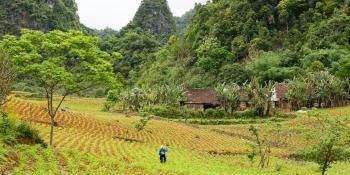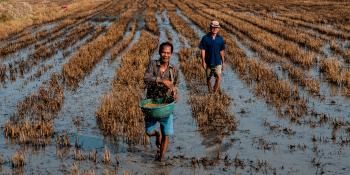Reducing greenhouse gases from livestock: Seeing the big picture

New study details the mitigation potentials of improved livestock management practices and moderating meat consumption
A new study published in Nature Climate Change reveals the mitigation options within the livestock sector that offer the most potential for reducing greenhouse gases (GHGs). Led by Dr. Mario Herrero at Australia’s Commonwealth Scientific and Industrial Research Organisation (CSIRO) and involving researchers from CCAFS and many other institutions, the paper emphasizes the importance of looking at the big picture when it comes to finding sustainable ways to intensify meat and milk production.
Seeing the big picture is important because some changes that scientists propose for reducing GHGs could actually end up resulting in higher GHG production. Take, for example, the use of more digestible feed to increase the production per unit. If a dairy farmer starts feeding her cattle with grain, it could reduce the amount of methane produced per cow and increase the amount of milk produced. The farmer could then get the same amount of milk from fewer animals and produce less methane, one of the biggest GHGs. But, she might then actually increase her herd size to increase her profits, and the end result would be not fewer animals and less GHG production, but more of both.
Many methods for reducing emissions could free up land that would otherwise be needed for livestock production.
Well-designed policies that consider the big picture are needed to avoid negative consequences like the hypothetical example above and to provide proper incentives for sustainably increasing livestock production. Such policies and practices can provide other environmental benefits beyond GHG reduction. Many methods for reducing emissions could free up land that would otherwise be needed for livestock production. The land that is spared can be used to grow food for direct human consumption, produce biofuels, or replant of forests.
The paper’s authors also evaluated how much emissions could be reduced under different scenarios of reduced meat consumption. While reducing meat consumption among well-fed populations that eat enough protein and get the necessary levels of micronutrients would be useful, it is not desirable for all populations, especially those households in developing countries where consumption of livestock products is a critical part of food and nutrition security and helps growing children achieve their full potential.
According to Dr. Herrero, “We can get the best mitigation potential from the livestock sector if we take a wide view of land use and practise change that considers the whole of agriculture and forestry, as well as looking at dietary patterns and how we meet the needs of global nutrition.”
Further reading:
- Dr. Herrero’s blog on The Conversation: To reduce greenhouse gases from cows and sheep, we need to look at the big picture
- The Cattle Site: Livestock Industry Can Deliver Food Whilst Reducing Emissions
- Phys.org Environment: Greenhouse gas mitigation potential from livestock sector revealed
- ILRI Blog: Livestock can significantly reduce greenhouse gases AND deliver benefits to the poor
- Press release from CSIRO: Greenhouse gas mitigation from livestock sector revealed
- Article in Nature Climate Change: Greenhouse gas mitigation potentials in the livestock sector (limited access)
Laura Cramer is a consultant with the Policies and Institutions flagship program.



